167+ AMAZING Greece Facts
Are you looking for a way to explore the Ancient Greek gods for kids? How about simply interesting facts about Greece, both past and present?
Facts about Greece span thousands of years, from information about Ancient Greece to the culture of Greece today.
The following facts about Greece are sure to blow your mind!
15 Key Greece Facts
These fun facts about Greece talk a little more in detail about the country as it stands today, from its official name to its population to its place in the world. If you’re ready for some Greece fun and facts about Greece, let’s dive right in!
1. Greece’s official name is the Hellenic Republic, which is also known in the Greek language as Ellada. The Republic covers mainland Greece and several islands.
2. The flag of Greece is blue and white, with a white Christian cross in the top left corner on a blue background. This is because the culture of Greece is highly Eastern Greek Orthodox Christian! The flag of Greece also has nine alternating blue and white horizontal stripes that make up the rest of the flag. One of our favourite fun facts is that the nine stripes represent the nine syllables in Eleftheria e Thanatos on the flag of Greece, meaning “Freedom or death” – the country’s motto.

3. A fun fact about Greece is that it is famous for democracy. The country is called the”birthplace of Western civilisation”! Greek democracy was the first example of this political system in the world.
4. The population of Greece is more than ten and a half million people. About 3.2 million live in the capital city, Athens, while 814,000 live in the second biggest city, Thessaloniki. Many older Greeks live near the sea or in the country, miles from major cities, in small villages, though urban centres keep growing, especially on the beautiful islands!
5. Greece is one of the most unilateral countries in Europe regarding religion. When it comes to Hellenic religion, 93% of the population is registered as Christian, and 90% of them are Greek Orthodox. 4% are without religion, 2% are Muslim, and all other religions make up only 1%. The Greek religion’s name is technically Eastern Orthodox Christianity.
6. Many people wonder, “how many islands does Greece have?” The answer is that there are more than 2,000 islands in total! 170 of them count as an inhabited island, though. Some famous Greek islands include Santorini, Mykonos, Evia, Rhodes, and Crete. Crete is the biggest island in Greece and a popular place for tourists to visit.
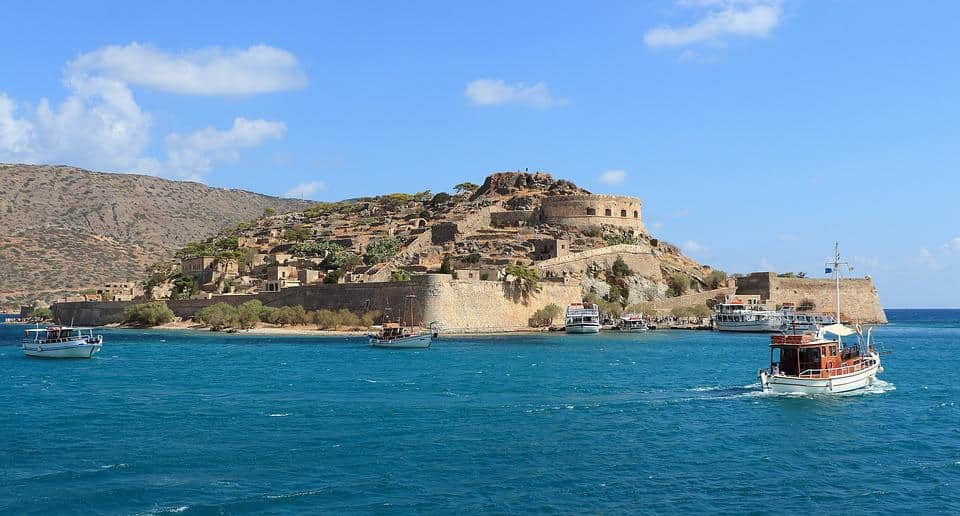
7. The official language of the Hellenic Republic is Modern Greek (or Ellinika). 13.5 million people speak it and is a direct descendant of the Ancient Greek language. Pronunciations have changed, as have some letters, but one of the interesting facts about Greece is that Ancient Greek writing and Ancient Greek letters are very similar to the modern Greek alphabet, though most modern Greeks can’t read Ancient Greek.
8. Greeks love coffee! There’s a café on every corner, and many social situations happen over coffee. Greece ranks 17th in the world for coffee consumption, less than Germany but more than France.
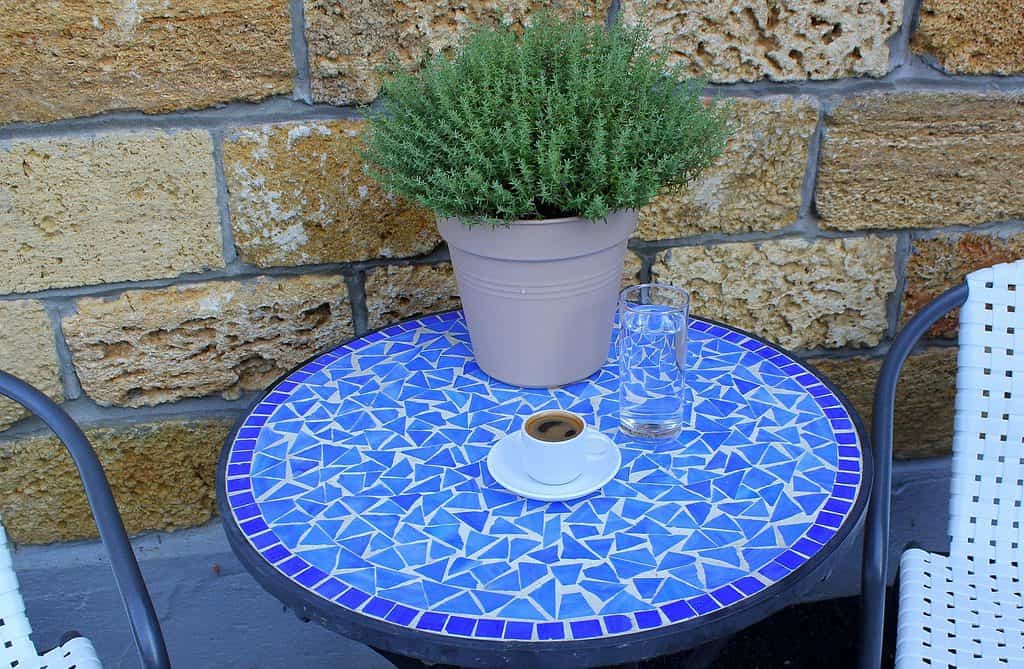
9. Agriculture makes up more than 12% of the Greek labour force. Greece is one of the biggest raw cotton producers globally, as well as pistachios, rice, figs, almonds, tomatoes, watermelon, and tobacco. They’re also a famous producer of olives – in fact, Greece is the third in the world! After all, you need a good producer of olives if you’re going to have olive oil in your delicious Greek salad!
10. Tourism accounts for more than 20% of Greece’s economy. This includes visitors from Europe, national visitors, and people who visit from the rest of the world. Its main attractions are the sea, the archaeological museums, its UNESCO World Heritage sites, and, of course, Ancient Greek mythology, religion, and culture.
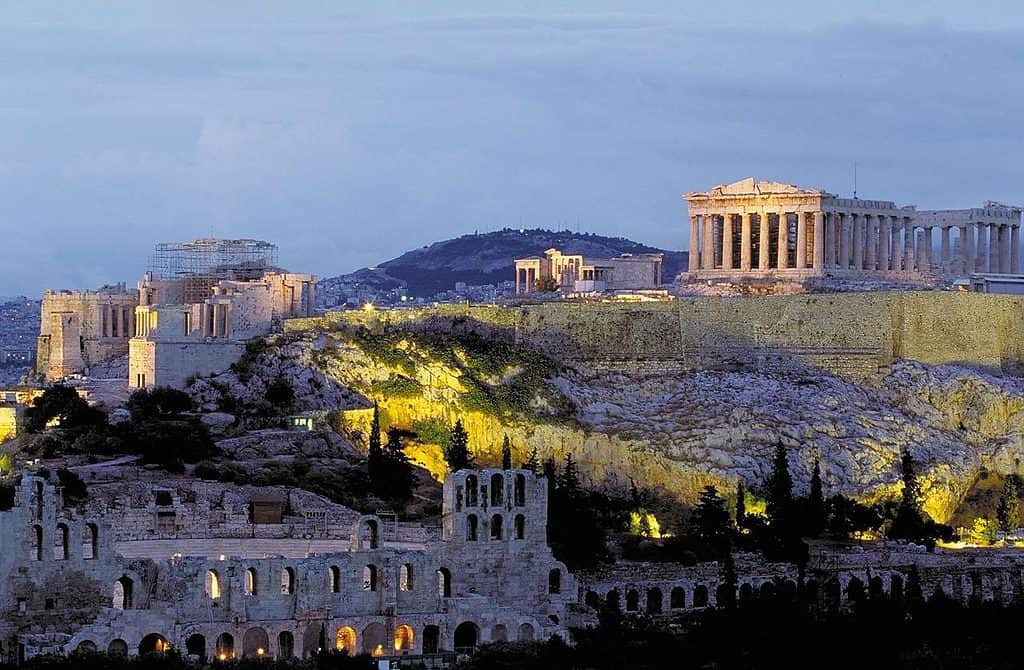
Interesting Facts About Greece
These fun facts about Greece go a little more in-depth, from olive oil to the Olympic Games to how the country operates in the world today! If you’re looking for facts about modern Greece civilisation, this one’s for you.
11. Greece has more archaeological museums than any other country globally. Most of these are dedicated to the gods of Ancient Greece, Ancient Athens and Olympia, Ancient Greek art, paintings of Ancient Greece, and more. Many are associated with a living monument, such as the long-standing Acropolis of Athens.
12. One of the most interesting facts about Greece is that most young adults, at least those who live in the cities, speak English to a reasonable degree. This is considered very important, especially as tourism is vital to their economy! Many Greek businesses also have signs and names in English.
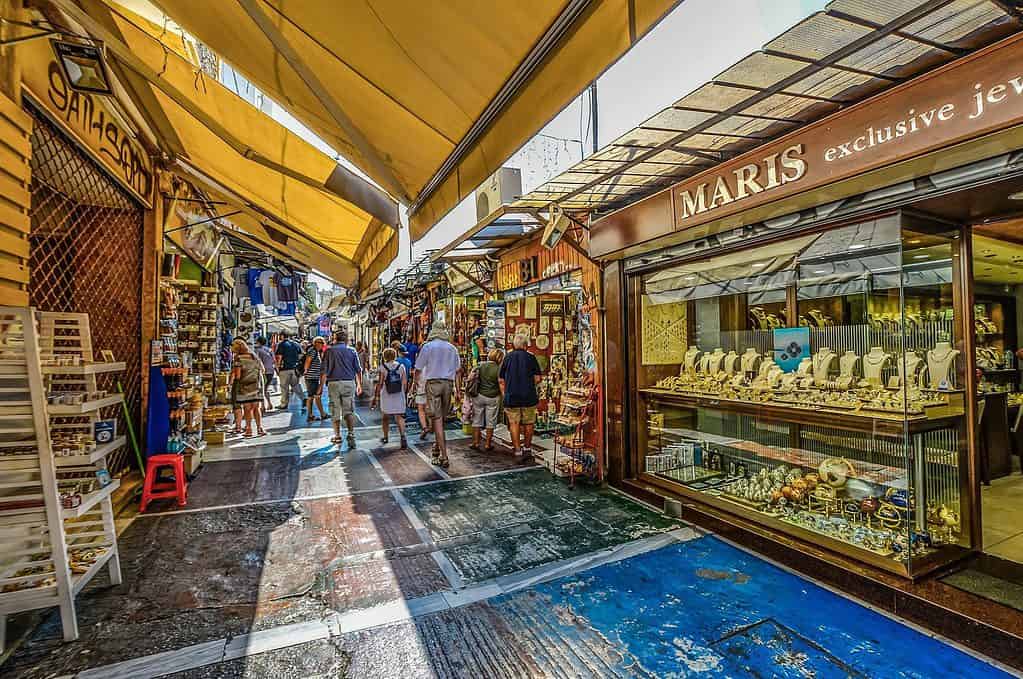
13. Greece is proud of its place in Europe and its stance in the European Union, through its culture, has a lot of Eastern influence. This is a lot to do with the Ottoman occupation and other overlapping cultural influences.
14. Facts about modern Greece aren’t complete without mentioning the Olympic Games! The modern Olympics started in Athens in 1896, thousands of years after the first Olympic Games in Olympia.

15. Greeks love their beaches! Whether on an island like Mykonos, or the mainland, the Greek coast is famous for its blue seas, sandy or pebbly beaches, and some of the world’s most swimmable water. 515 Greek beaches are Blue Flag certified—the world’s marker for amazing beaches!
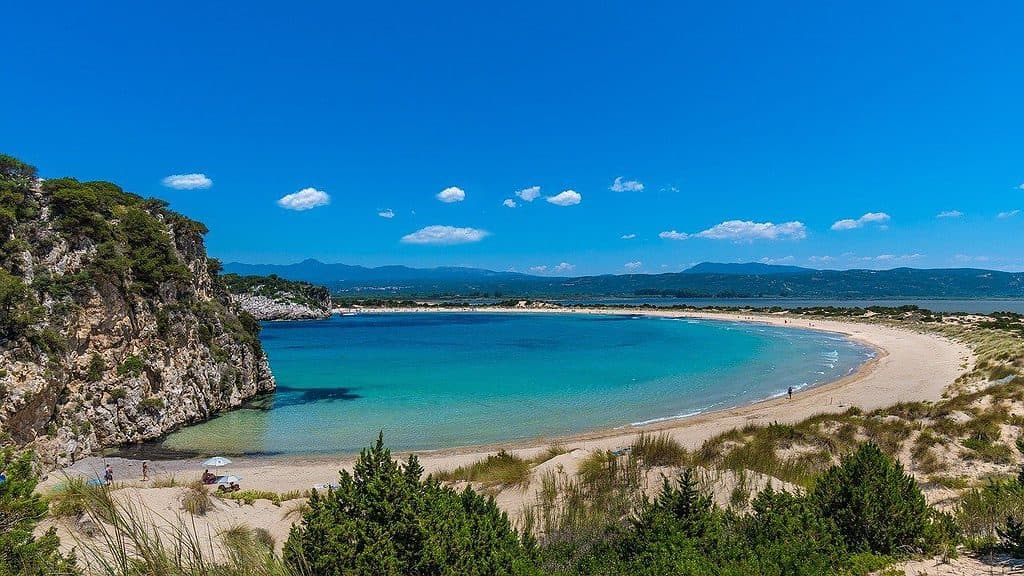
Greek Culture Facts
16. As well as a birthday, people in Greece get a name day – that’s right, two days of presents! The name day is an Eastern Orthodox tradition where a person is celebrated on the saint’s feast day for whom they are named. They celebrate one of the All Saints days if they are named after something else (most commonly an Ancient Greek name).
17. The first nude scene in European cinema was in a Greek movie! Daphnis and Chloe was the first-ever Greek film shown abroad in 1931, and it contained the first cinematic nude scene in Europe.
18. Greek Carnival (apokries) starts in February, 10 weeks before Orthodox Easter, and is a whole month of fun, games, costumes, parades, and more! Though it’s Christian, it has its roots in Greek god’s facts, as the wine, food, and revelry is the realm of Dionysus. Some of the world’s best parties take place in the country then!
19. Tsiknopempti (Smoky Thursday) is when Greeks eat a lot of meat! It’s part of the country’s carnival celebrations and takes place on the Thursday of the second week. There are many barbeques, costumes, and more!
20. Only 3/4 of Athens’s population is Greek-born—around 25% of the Athens, Greece, population moved there from countries worldwide.
21. There’s no part of Greece more than 85 miles from the sea!
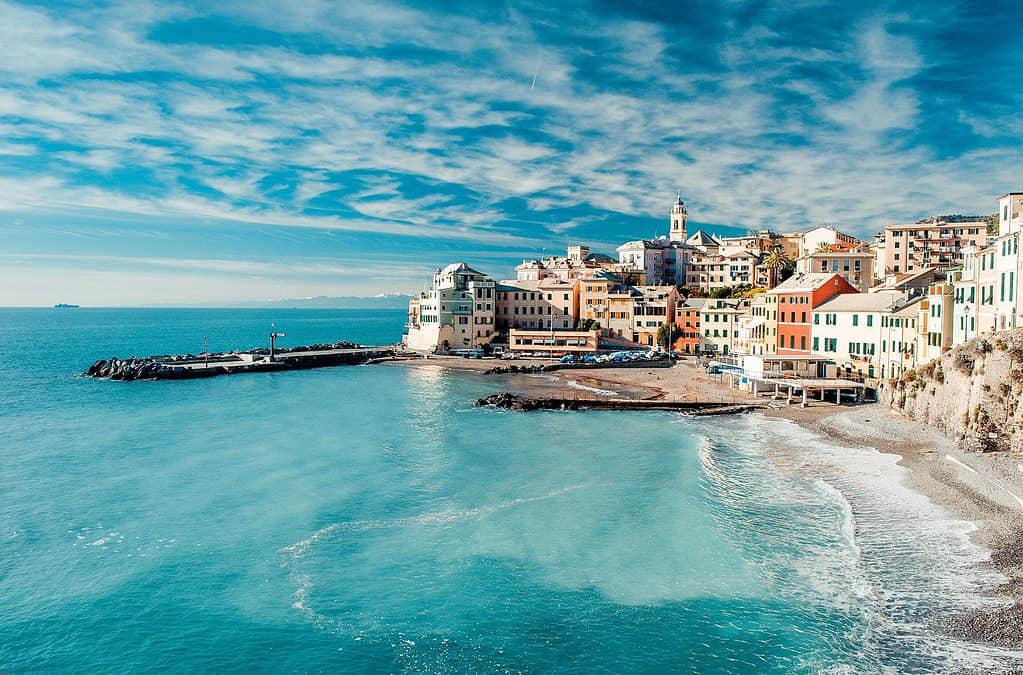
22. Greece is the world’s largest producer of sea sponges.
33. There are more than 4000 Greek traditional dances.
34. Roman Athens existed under 500 years of Roman rule, but the city never lost its main focus as a place of art and scholarship. It was known by the Romans as a “city of Hadrian”!
35. Along with Greek andmarks like the Ancient Agora, Greece is constantly finding new ruins as it excavates its cities. Many subway stations have free mini-museums inside of things found when digging to lay the lines!
These Greece facts include things like life in Athens, information about holidays, and modern-day superstition. Greece is still alive with culture, and here are some fun facts!
36. Many people in Greece perform the sign of the cross upon themselves whenever they pass a church or a roadside paraklesi or ekklisakia. It’s especially common for older people and is so ingrained that if someone moves the bus, many will follow automatically!
37. Many older and more superstitious Greeks still believe in the evil eye. The evil eye or mati is a curse brought upon someone by a glare or highly negative thoughts, and many use talismans to protect themselves from it.
38. Many people in Greece have the same name! This is because it is still common for sons to be named for their grandfathers and daughters for their grandmothers. For example, if Dimitris and Anna’s son had four children (two boys and two girls) with Konstantinos and Maria’s daughter, the children would likely be called Dimitris, Konstantinos, Anna, and Maria. When the genders aren’t balanced, feminised versions are sometimes used: if all four were girls, they might be Dimitra, Konstantina, Anna, and Maria. This isn’t a rule, but it’s a very strong tradition.
39. There are two forms of direct address in Greek. The informal singular version (εσύ, esi) refers to a family member, friend, or social equal. It also changes how words are conjugated. For example, the greeting “Hello! Are you well?” would be “yia sou, eisai kala?” in informal but “yia sas, eiste kala?” in formal plural! In formal situations, such as a teacher, an elder, or simply meeting someone new and being polite, εσείς (eseis) is used instead.
40. Most Greek shops don’t open on a Sunday, and those usually open with special hours (with some exceptions, especially for foreign businesses). Supermarkets and non-essential pharmacy services are common closures that catch tourists off guard!
41. Gift exchange at Christmas traditionally happens on New Year’s Day, not Christmas Day. However, this is slowly changing as Greek kids are more influenced by foreign media. Many families compromise on a mix of the two.
42. Greeks sing a different song than “Happy Birthday” when they blow out their birthday candles! The lyrics translate roughly to: May you live many years [name], may you grow old and get white hair, may you spread the light of knowledge everywhere you go, and may everyone say, there’s a wise person!
43. In market streets on small islands and small mainland villages, the vendors will often call visitors over to try their wares and insist even if the visitor doesn’t buy anything – they don’t mind, they just want you to sample something they’re proud of!
44. Animals are very important to Greeks. Laws are constantly being updated to curb breeding practices and unfair treatment of animals. There are many stray cats and dogs in the cities, and the locals and the municipalities look after them. There are lots of adoption drives, too!

45. Theatre trips are an extremely popular pastime in Greece. There are 148 theatres in Athens – more than any other city in the world!
Modern Greek Facts
Modern-day Greece facts are just as exciting as anything about the past. Home to over 10 million people, the national culture from facts about Greece food to modern Greek democracy to its place in the European Union and Europe – it’s a competitor for the most interesting modern country in the world!
47. Greece is the third highest-rated European destination for holidaymakers. Even though travel was restricted, more than 10 million people visited Greece in 2021! Many people want to relax on beaches on a Greek island or explore the marine life of the coasts. In contrast, others are more interested in the most famous things about Greece—the history and archaeological wonders, many of which are right there in the capital city.
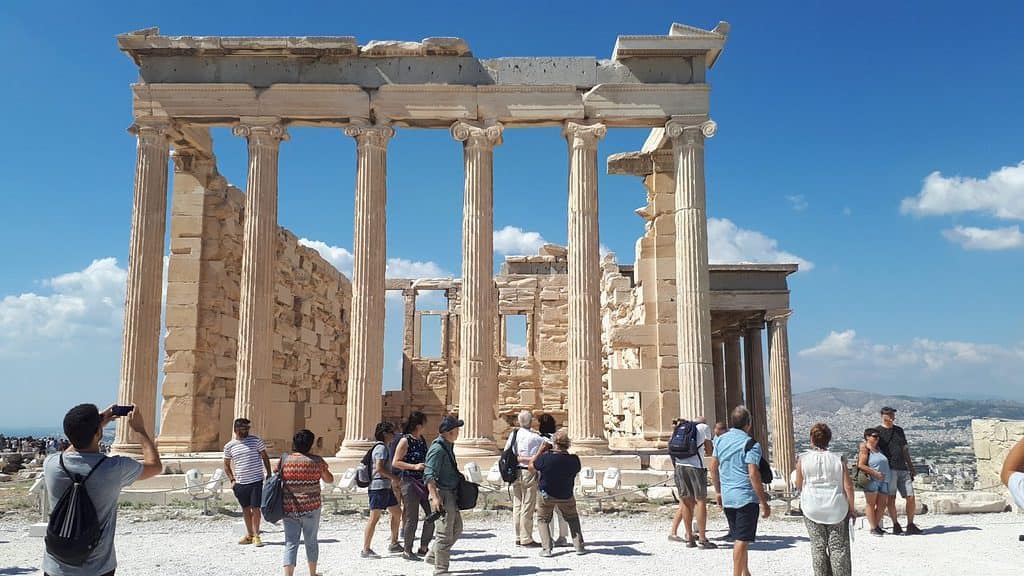
48. The population of Athens, Greece, is considered highly metropolitan, especially as it is made up of a high number of immigrants. As well as EU citizens welcomed by national open borders, many people from countries like Israelis, Eastern Europeans, British, and Turks come to Greece to live and work, whether from near or many miles away.
49. The current Greek national anthem, Hymn to Liberty, was written by Dionysios Solomos—whose name means Dionysus Salmon! Based on the length of the text, it’s the longest national anthem in the world.
50. Many modern concepts are referred to in conversation by English terms. For example, most Greeks refer to their heating/cooling unit as “air condition!” They also use a lot of English slang and sometimes “Greekify” English words like ‘tag’ (as in, on social media) by adding a Greek verb ending—aro.
51. Kids in Greece sometimes do “strikes” of their own, where they “occupy” the school in protest over something serious.
52. Greek democracy facts are changing, as the country has been politically turbulent for quite some time. There are two main leading parties, though unsurprisingly, each has its problems!
53. In cities like Thessaloniki and Athens, location matters. Depending on where you live, the price of a home can vary by thousands of euros – especially if you want to live in the city centre or near the beachfront!
54. The national alcoholic drink of Greece is ouzo – and it’s strong stuff!
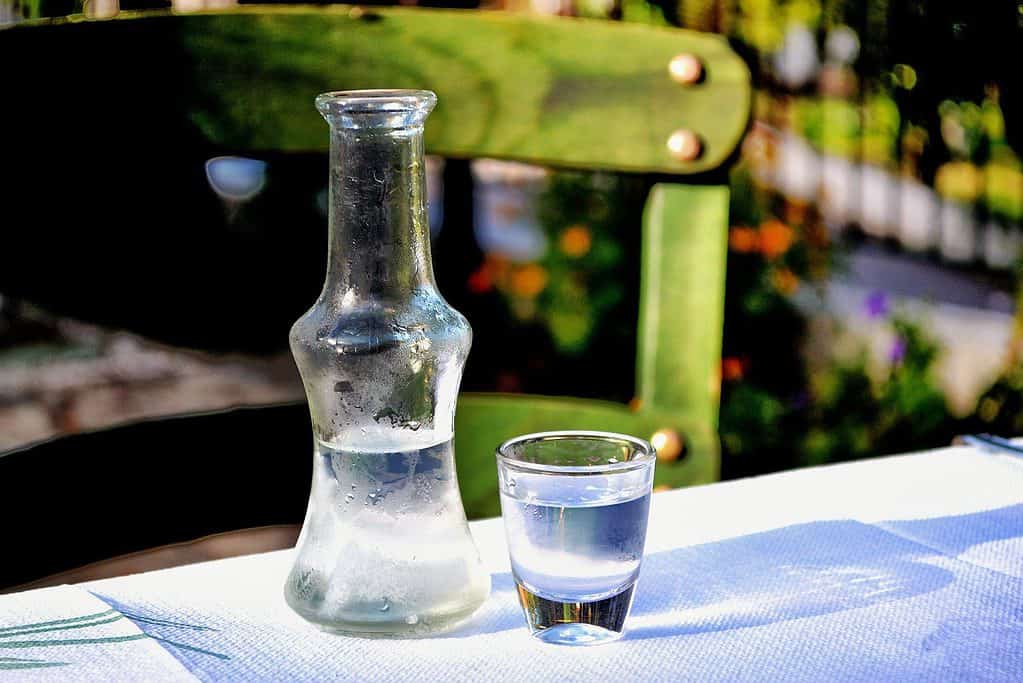
55. All Greek men are obligated to perform six to nine months of military service when they come of age.
56. Easter is a more important holiday than Christmas!
Greek History Facts
Greek history spans a long time! Modern history has been considered anything since the Ottoman Empire, while other historical events take place between Ancient Greece and now. That’s a lot of history!
57. Modern Athens history and much of the rest of Greece is filled with revolutionary protests, such as the 2010-11 anti-austerity protests and many modern protests about worker’s rights.
58. In June 1925, a man named General Theodoros Pangalos led a coup and became the dictator of Greece. This only lasted a year before he was overthrown and the Republic was restored.
59. During WWII, Prime Minister Ioannis Metaxis was presented with an ultimatum from Benito Mussolini: he would allow the Axis powers to occupy parts of Greece, or they’d go to war. Metaxis said no, and replied, “Then it is war!” People took to the streets in the morning chanting ohi (no) as the Greeks resisted the invasion. This is still celebrated every October 28th, known as Ohi Day.
60. The Greek military junta of 1967–1974 happened when Colonel Giorgos Papadopoulos led a coup d’etat and established a successful, austere dictatorship. He was eventually overthrown after a lot of civil unrest and bloody protests, and the democratic process returned in 1974. Civil liberties were curtailed, and people lived in harsh conditions.
62. Greece was one of the countries that suffered the most during the 2008 global recession. The country was so in debt that they nearly had to leave the EU – fortunately, they’re on their way back up!
63. The Greek Revolution took place between 1821 and 1829, and it was a successful war of independence that freed Greece from the Ottoman Empire. March 25th is Greek Independence Day.
64. Many Greeks migrated to the US between 1890 and 1945, hoping to escape economic and other hardships brought on by the wars and discontent at home. There are now significant Greek populations all over the US.
65. Istanbul is still called Konstantinoupolis (Constantinople) in Greece! The city was known as that for 2000 years before the Ottoman occupiers changed the name to Istanbul, but the name change never stuck in Greek. Ironically, Istanbul is also Greek – it’s from eis tan polli, a medieval Greek phrase meaning “to the city”.
66. A monk in the self-governed area of Mount Athos, where women are still prohibited to this day, lived for 82 years and died without ever having seen a woman in his life. He never left Athos and never knew what a woman looked like! Mihailo Tolotos’s mother died when he was born and the Athos monks entirely raised him.

67. Babis Bizas holds the Guinness World Record for the most travelled man on Earth. He was born in Epirus, Greece, in 1954 and has visited both the north and south poles – the only Greek and one of the few people ever to do so. In 2004, he completed his goal of visiting every sovereign country globally!
68. Greece last held the Olympics in 2004 and was a piece of modern Athens Greece history. Greece won 16 medals – 6 gold, 6 silver, and 4 bronze.

69. In 2001, Greece was amongst the first countries to join the Eurozone, changing their currency from drachmae. When the Euro was officially established in 2002, one Euro was worth 370.75 drachmae.
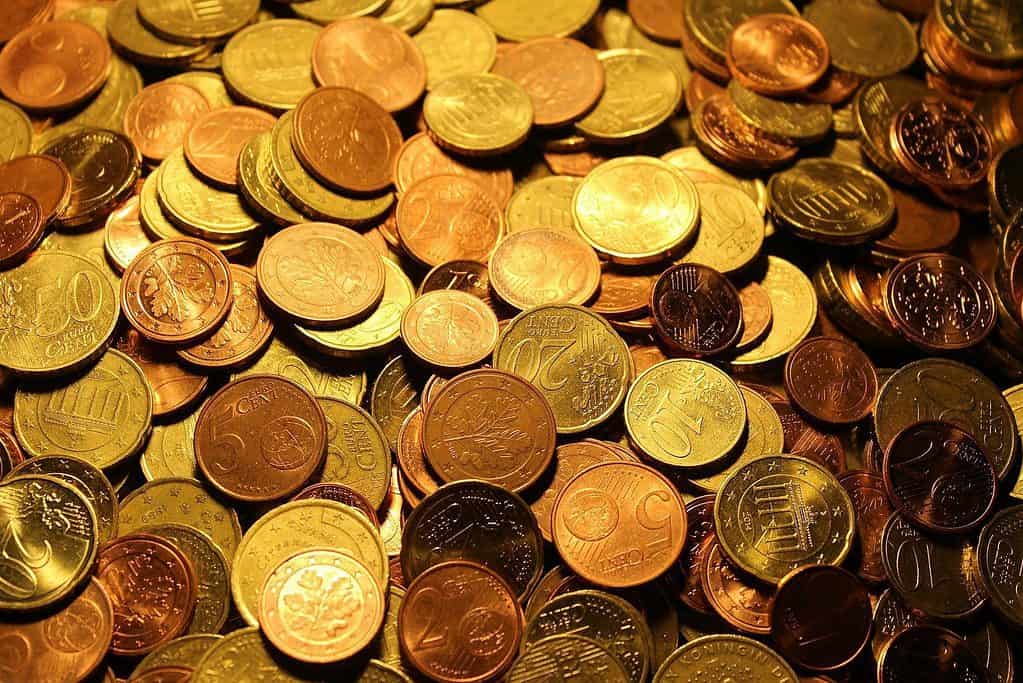
70. Greece has only won the Eurovision Song Contest once, in 2005. The contest was held in Athens the next year and won by Finland.
71. The UEFA World Championship in football in 2004 was a massive success for Greece – they won the final against Portugal 1- 0!
72. The modern Greek navy has never lost a battle since it was created in 1821 during the Greek Revolution!
Greek Mythology Facts
A popular topic right now is Greek gods and goddesses for kids and adults alike. These Greek god facts for kids cover some of the best Greek myths for kids as well as general Greek gods and goddesses facts.
73. When it comes to facts about Ancient Greece, gods are everywhere! There were gods, demigods, and other similar religious beings representing everything from trees to childbirth to abstract concepts such as truth. None of the gods was truly good or truly evil in these Ancient times – though they often did wrong, true evil was usually punished.
7.4 History for kids, Greek gods edition, are always some of the most fun facts about Greece! Five original Olympians plus their brother, Hades, became Lord of the Underworld. The gods and goddesses of Ancient Greece all followed the Olympian rule. The original siblings were Zeus and Hera (who married), Hestia, Poseidon, and Demeter. The rest of the Olympians were Athena, Artemis, Apollo, Dionysus (who often replaced Hestia), Hermes, Hephaestus, Aphrodite, and Ares. All (usually except Aphrodite and Hephaestus) were Zeus’s children
75. Many of the Greek gods’ kids lived as humans, though many also became demigods or even gods in their own right. Heracles was a famous hero as a human, and when he died, he became a god! Dionysus was the only half-human among the Olympians.
76. Ancient Greece fun facts often centre on rivalries. One of the biggest was between Athena and Poseidon, who competed to impress the humans of historical Athens and become the city’s patron. Poseidon made a fountain spring from the ground, but it was salty, and the humans rejected it. Athena, meanwhile, made the first olive tree and was accepted as the city’s patron.
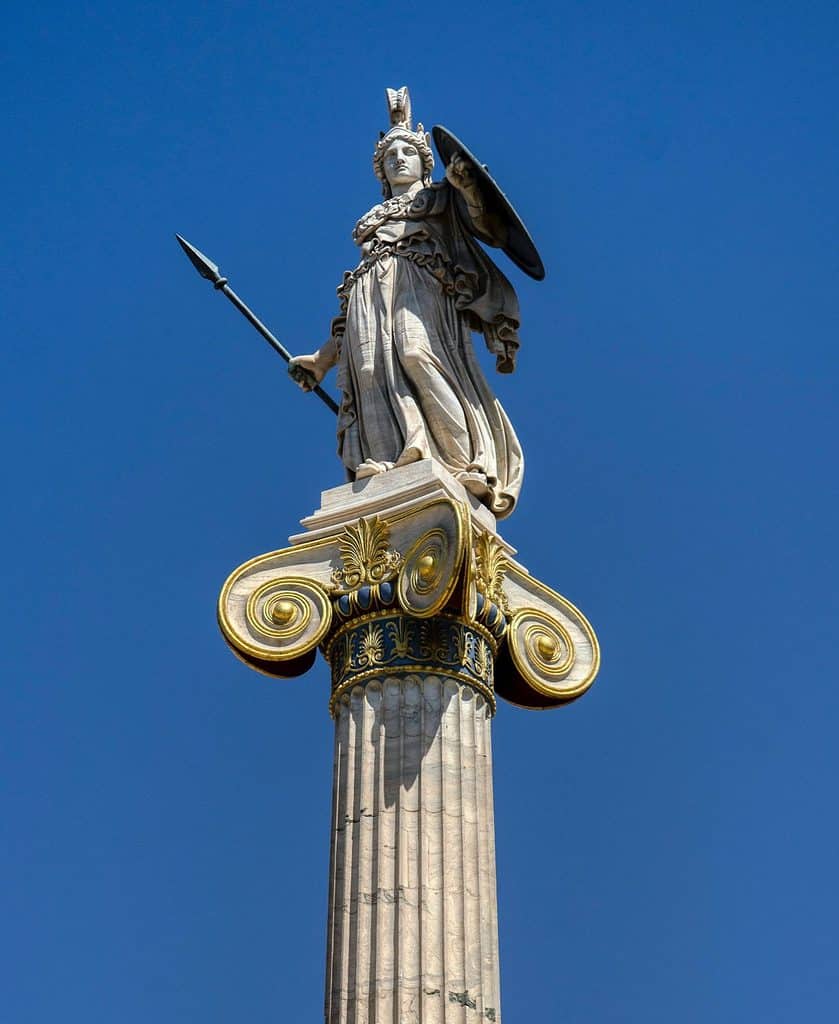
77. Ancient Greek beliefs centred on temple worship. The Parthenon, which you can still visit at the top of the Acropolis of Athens, was one of the biggest temples of Athena, placed at the highest point in the city.
78. One of our favourite fun facts about Ancient Greek religious beliefs is that they wouldn’t say the name of Hades, as they did not want to attract the attention of the god of the dead. Instead, if they had to refer to him, they would use “Plouton”, meaning “the wealthy one”.
79. In Olympia, Greek mythology centred around Zeus, as this was the location of his main temple of worship. A weird part of Olympia, Greece, history is that it’s nowhere near Mount Olympus – despite its name!

80. The Ancient Athens population was aligned with Athena, while the Spartans were aligned with Ares. Though Greeks respected all the gods, different gods had different cult sectors and worship areas.
81. Many gods married their siblings, parents, or other family members. Zeus even had children with several of his own grandchildren! While this was normal for gods and Titans, though, it was absolutely forbidden amongst humans. When King Oedipus of Thebes found out he’d accidentally married his own mother, he blinded himself as punishment!
82. Hermes was a very versatile god! As well as a messenger, he was a god of travellers and wayfarers, thieves, shepherds, athletes, markets and commerce, wit, sleep, speed, roads, boundaries, and more. He was also a psychopomp (a person who guided souls to the underworld). Good thing he was so fast!
Ancient Greek Facts
Interesting facts about Ancient Greece were everywhere – not just on Olympus! The following Ancient Greece facts and information are about the people and culture of Ancient Greece’s day-to-day life and history, including Ancient Greek democracy facts, facts about Ancient Greece pottery, Athens Ancient Greek influence Ancient Athens facts, and more!
83. One of the weird facts about Ancient Greece is that many people claimed to be directly descended from gods – and they were usually believed. The male gods had so many affairs with human women that it was almost more unusual NOT to be related to a god!
84. Ancient Greek Sparta facts: The myth about the Spartans throwing babies off of cliffs if they weren’t strong enough was completely untrue! Athenian Greece often looked down on the warlike Spartans, and most Ancient Greek writing came from the Athenians – in short, they made it up!
85. Ancient Greece fun facts shouldn’t leave out some of their weirder traditions. For example, athletes performed naked – which couldn’t have been fun if they got hit in the wrong place by a misaimed discus!
86. Ancient Greek democracy is often called Athens democracy, as that’s where it originated. Thinkers and philosophers ran the major government in Ancient Greece, and Ancient Greek politicians often spent days arguing. Of course, other regions of Ancient Greece had no interest in the Athenian government – as a result, their versions of Ancient Greek politics were very different!
87. Much of what we know about Ancient Greece comes from Ancient Greek pottery and Greek ceramics. Ancient Greek artists used Greek pottery art (such as an Ancient Greek vase) to depict Greek spirituality and Ancient Greek religions. There were different types of Greek pottery, and you can tell from things like the Greek pottery design, the Greek vase shape, and the Greek vase patterns where it came from. For example, an Ancient Greek urn or a Greek vase designed from Santorini would look different from Greek pottery from another Greek island.

88. Painting and Ancient Greek drawings are also very important when studying Ancient Greece. The paintings of Ancient Greece often involved Ancient Greek portraits, many of which were used as references for statues. The olive tree was an important symbol in much art, as were different varieties of olives and other harvests to symbolise life in Greece. Blue was and remains a very popular colour for painting in Greece.
89. The Ancient Athens government was just one of several political powers across Ancient Greece. Greece was split into many autonomous regions, and they had little to do with each other in terms of governance.
90. In addition to places like Athens and Olympia, Greece had temples everywhere! There are temples in Armenia, Turkey, Italy, and more! Many are in areas that are no longer part of Greece in the modern world.
91. Nobody really knows what kind of Ancient Greek flag or flags might have existed, though it’s sure that the states didn’t share one. Flags, as we know them, now became a record in Greece during the Byzantine Empire.
92. The most interesting point on an Ancient Athens map would be the Long Walls, two extensive walls that spanned the city from sea to sea and ensured they could access their ports even when the city was under siege!
Greece Food Facts
93. Olives, olive trees, and olive oil have always been an essential part of Greek food! Olives were so important that an olive branch is still considered a sign of peace today, and the olive represented the land’s wealth, health, beauty, wisdom, and fertility.

94. Feta cheese is a dairy product of national pride! It’s a briny white cheese that is only made in the country. One of the most interesting facts about Greece is that any cheese made outside of the area and in other countries is not really feta!
95. Greek salad is called horiatiki (village salad) in Greek. It’s dressed simply with oregano, salt, pepper, and lots of olive oil, often soaked up with bread after the salad! The famous salad is made up of tomatoes, cucumbers, onion, slices of feta cheese, and olives.
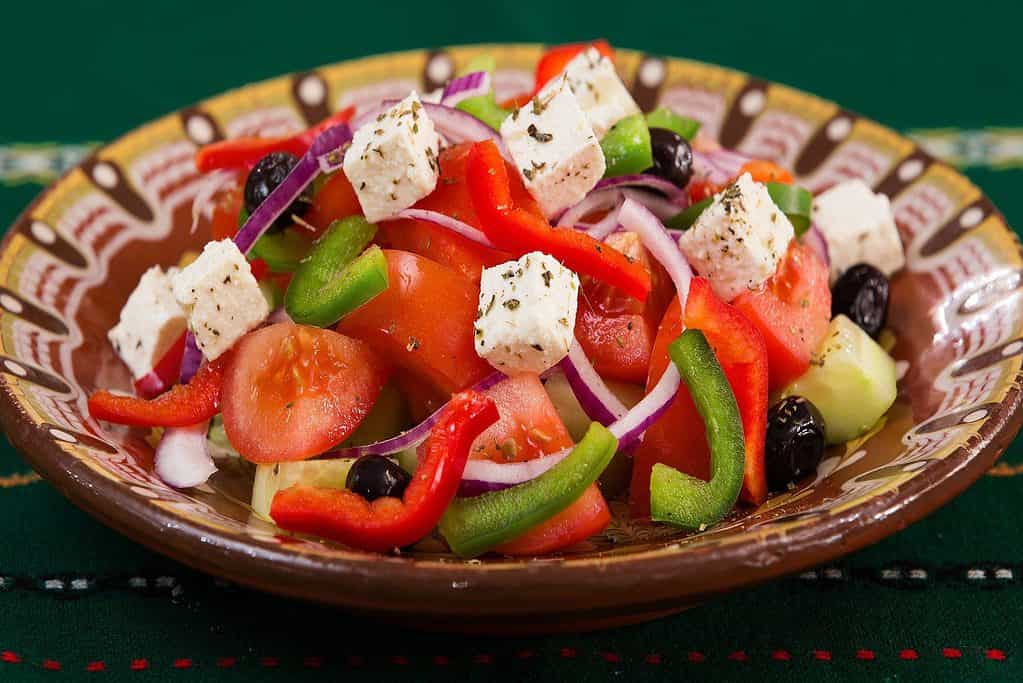
96. Some of the most famous Greek foods worldwide are gyros (pronounced YEE-ros) and souvlaki. These are similar to kebabs, usually made of lamb, chicken, or pork and served in a delicious pita wrap or sandwich along with fries, sauces, and salad.
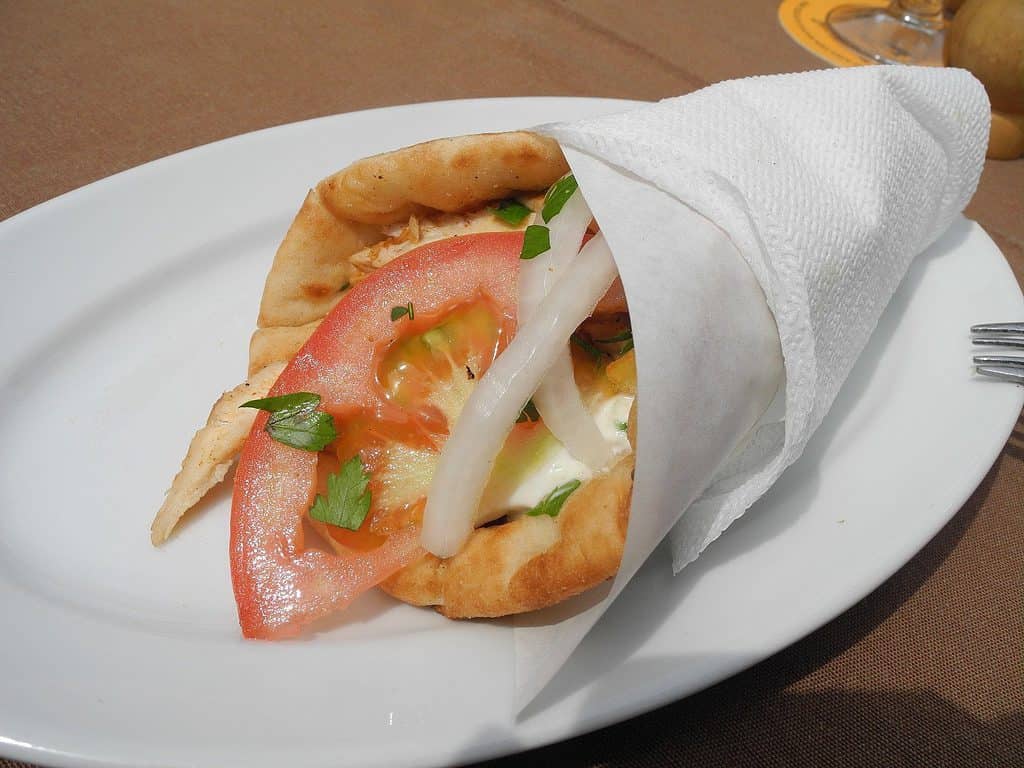
97. A vasilopita is a traditional cake or bread eaten in the new year. It’s baked with a coin inside, and the person who finds the coin in their slice will have good luck for the following year!
Facts About Ancient Greece Clothing
98. Since the weather was usually very hot, most Greek clothes were light, loose, and colourful.
99. Men wore a tunic called a chiton that was held in place at the shoulders with pins. They were made of wool in the winter and linen in the summer.
100. Women’s dresses were made of the same material as chitons. They were huge pieces of cloth wrapped around the women and pinned in various places, and they always went down to the ankles.
101. Leather sandals were expensive and mostly for the rich. Though boots were common in the winter for those who could afford them, most Greeks went barefoot year-round.
102. Greeks spent a lot of time on their hair! Curls were in fashion, and women would have long hair in intricate braids.
Ancient Greece Alphabet Facts
103. The Ancient Greek alphabet was more or less the same as the modern alphabet, though pronunciations and letter combinations differed. Many differences have happened over time, and in Modern Greek, the letters omicron (ο) and omega (ω) are both pronounced like the o in over, beta has become veeta (β), and epsilon (ε), eta (η), and iota (ι) all make an e sound like fee.
104. Ancient Greek was the basis for many other alphabets, including Latin and Cyrillic scripts.
105. Modern Greek doesn’t use the same diacritics (accent markers) as Ancient Greek. Diacritics are used to show how words should be pronounced, and the old system was much more complex.
106. Some localities used extra letters in Ancient Greek to fill in for sounds that didn’t exist in the main alphabet, such as the Ionian letter sampi (Ͳ), which made a ts or ss sound.
107. Other languages also used the Ancient Greek alphabet in antiquity, including Old Italic, Thracian, Iberian, Coptic, and more. Many Hebrew and Aramaic documents were also written with Greek characters.
Athens Facts
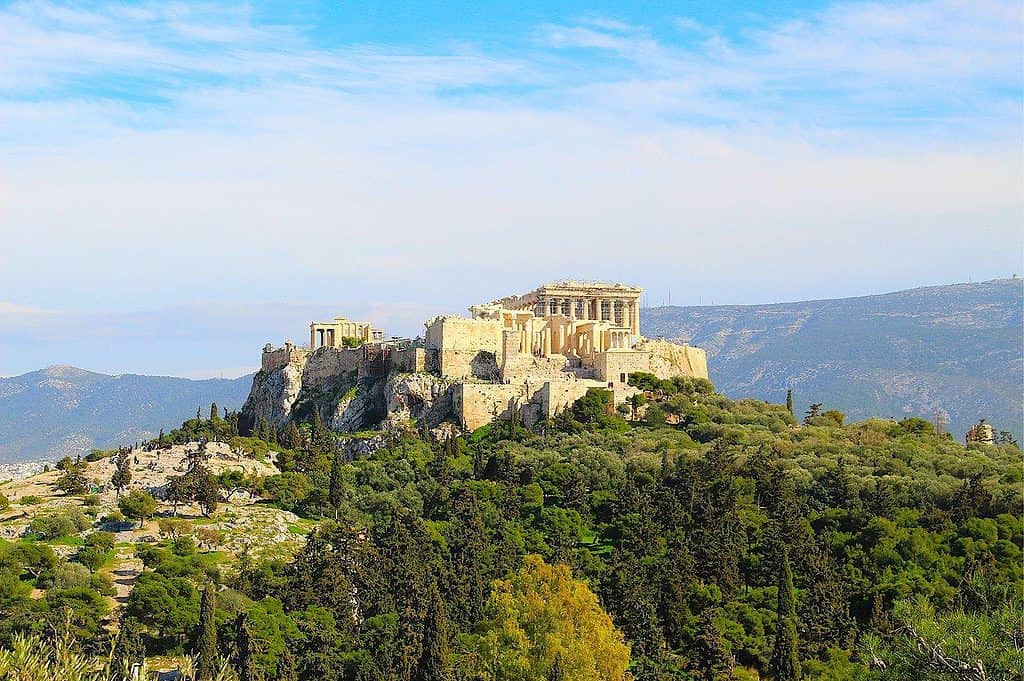
108. Athens in Greek is Athina, named for the goddess Athina (Athena), who is its patron – still after the Athens Ancient Greek origins. They are pronounced differently – while the city is ah – THEE – na, the name (still used for girls today) is pronounced ah – thee – NA.
109. Classical Athens was home to many of the famous philosophers we still quote today, from Socrates to Aristotle.
110. The modern city is very proud of historical Athens, and the archaeological sites are given pride of place and appropriate reverence. Many streets have been renamed after an old ruin was discovered!
111. Whether young or old, Athens has activities for everyone. They are a very tourist-focused people, and families are extremely welcome.
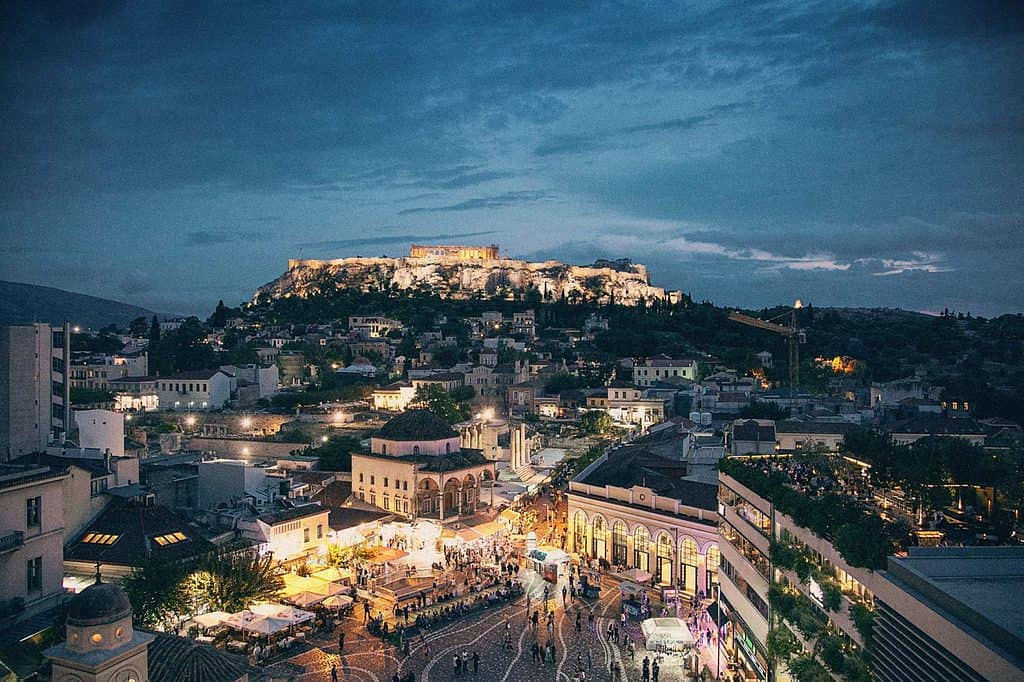
112. The modern Olympic games were held in Athens rather than in Olympia, Ancient Greece style. That was simply a matter of convenience – Olympia is a historical site, while Athens is thriving! The Olympic village in Athens is now used for various purposes, and some of the athletes’ houses are currently vaccination centres.
113. In Athens, public transport tickets are the same for buses, trains, trams, and metros. A single ticket gets you 90 minutes to go as far as you want on any combination of these – pretty convenient if you’re going sightseeing!
114. Athens Airport is connected to the city centre by a direct subway line and various buses and driving routes. It is named after Eleftherios Venizelos, a Cretan-Greek prime minister who was known as “the Maker of Modern Greece”.
115. Athens is the oldest still-functional capital city in Europe!
116. The Acropolis, which hosts the Parthenon and several other ancient buildings and temples, is called that for one simple reason – Acropolis means “highest point in the city”!
117. In its time, Athens has been ruled over every form of government known to man, from capitalism to communism to monarchy and beyond!
118. All sorts of architectural styles make up the buildings in Athens! You’ll find modern buildings alongside Neoclassical architecture as well as ancient Greco-Roman buildings and more.

119. Athens is the warmest major city in Europe!
120. Worldwide, several cities and towns are named for Athens. There are 34 places named Athens (including New Athens and West Athens) in the USA and one township named Athens in Ontario, Canada. Honduras, Costa Rica, Italy, Poland, Germany, and Ukraine all have places named Athens.
121. There are 58 municipalities in Metropolitan Athens, and each is very densely populated!
122. Athens is connected to Thessaloniki by rail.
Greece Olympics Facts
These facts talk about the origins of the Ancient Greek Olympics! From Ancient Greece Olympia facts to what actually went on in the ancient Olympia stadium, this section is all about the precursor to the modern Olympic Games.
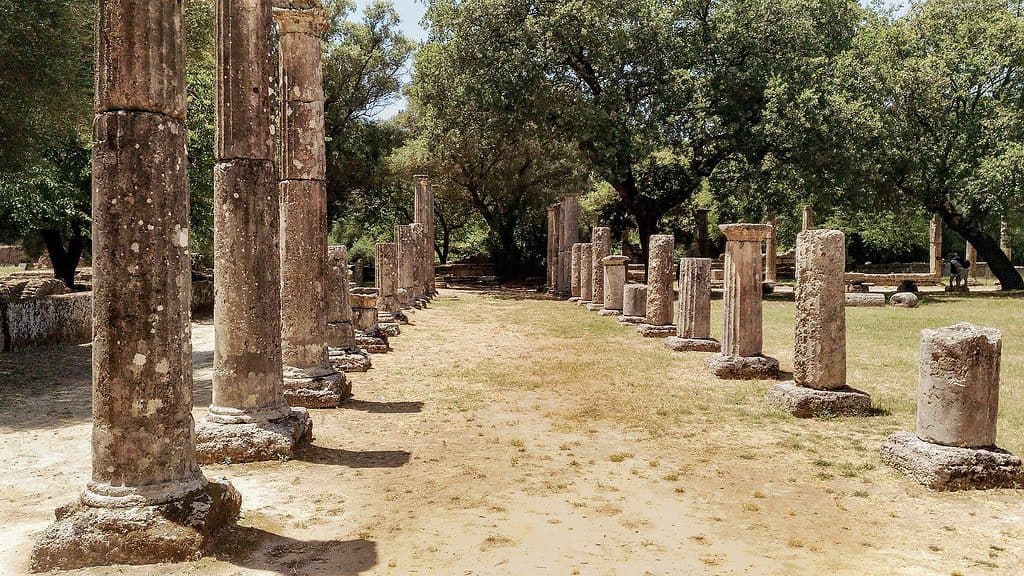
123. In Ancient Greece, Olympia was the home of the games.
124. On the Olympia map, Greece has more than 70 temples alongside the ancient stadiums. The Olympics were really a religious event!
125. During the games, warring Greek states would declare a ekecheiria – an Olympic truce – so visitors, religious pilgrims, and competitors could safely travel to the games.
126. The Ancient Olympics ran from around 776 BCE to 393 BCE – approximately 1,168 years! The event happened every four years, so there were about 292 Ancient Olympic games in total.
127. Only freeborn Greek men could take part in the Ancient Olympics. That meant they had to come from a Greek state, not be slaves or have ever been a slave, and not be a woman – though several women won victories for their chariots.
128. The first-ever Olympic sport was stadion, a foot race that was the only event in the Olympics from 776 to 724 BCE.
129. Winners of the Olympic Games were crowned with laurel wreaths.
130. The Roman Emperor Nero participated in the Olympic games as an equestrian athlete during the Roman occupation. He raced in a ten-horse chariot!
131. Several imitation Olympic festivals happened outside of Olympia, all over Greece and beyond to places like Italy and Libya.
132. Even today, there’s a ceremony at Olympia involving priests and the ritualistic lighting of the Olympic flame every time a game takes place.
Facts About Greek Islands
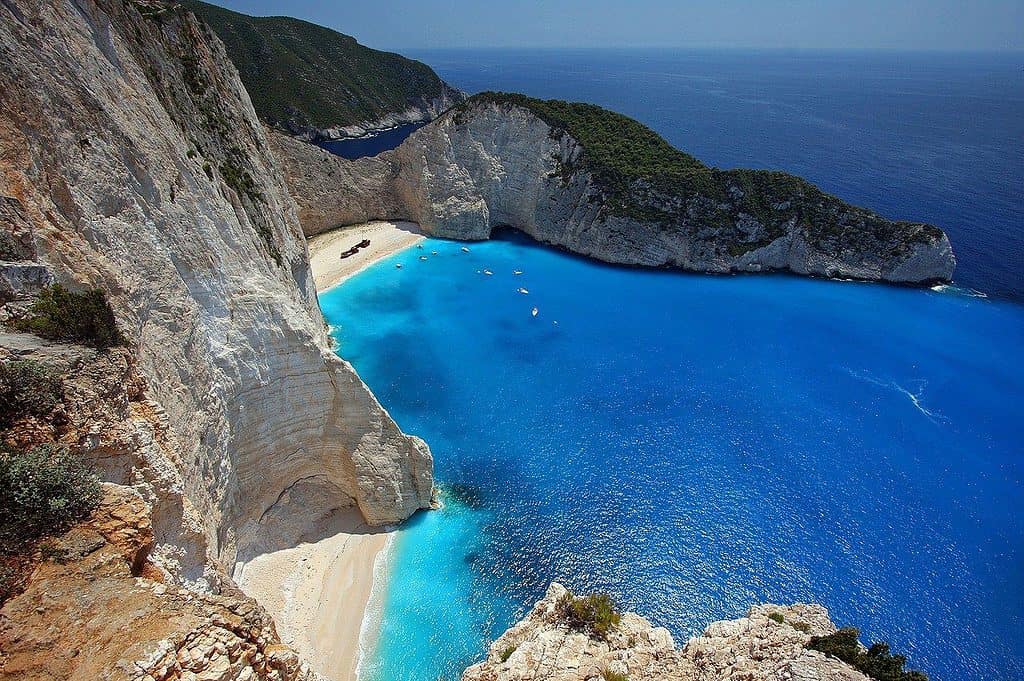
These Greek islands facts are specially dedicated to anyone who loves the sun, sand, and sea of arguably the world’s most stunning travel destination. Here are some of our favourite facts.
133. The ten largest islands in Greece are Crete, Evia, Lesbos, Rhodes, Chios, Kefalonia, Corfu, Samos, Lemnos, and Naxos. Each of these has its own culture and history, and many features in their own stories about Ancient Greek gods and goddesses, facts that are different between regions.
134. Mykonos is considered a party island and is often visited by students and bachelor or hen parties. It’s a place with lots of wine, miles and miles of bars and clubs, and an island for young people. Many young tourists go to Mykonos on their visit to the country, and they come from all over the world to experience the party atmosphere of this island on the Blue Sea! There are plenty of islands close to Mykonos to visit too.

135. Of the 15 international airports, most are on the islands. Heraklion Airport is in Crete, and Mykonos Airport is only 4km from the city! While Athens the City and Thessaloniki have their share of tourists, the other airports are island-based!
136. There are several groups of Greek islands with distinct cultures and architecture. Apart from Crete and Evia, the islands of Greece are sorted into The Ionian Islands, The Cyclades, The Sporades, The Dodecanese, The Saronic Islands, and The North Aegean Islands.
137. The Dodecanese islands are some of the most southern Greek islands near Turkey. There are 165 in total, 26 of which are inhabited and filled with castles and medieval architecture! Though the name means “12 islands”, there are actually 15 “main” islands in the group.
138. Gavdos, which neighbours Crete, is the southernmost Greek island and the southernmost place in Europe! Its population is tiny—around 150 people live there year-round.
139. The Greek island’s population makes up a significant part of the country’s population. Of the 10.5 million people living in Greece, about 15% live on the islands, amounting to about 1.6 million people.
140. In the Saronic Islands, the island of Agistri, Greece, is just over 5 square miles – but home to over a thousand people! Its name means “fishing hook”.
141. Also in the Saronic Islands is Dokos. This 5 sq. mile island is home to only Orthodox monks and sheepherders – about 18 as of the last census!
142. Facts about Greece’s history and mythology always include the islands, as they were the site of many mythological adventures. For example, the island of Naxos in the Cyclades is very important in Greek mythology. It’s where young Zeus was raised, where Thesueus was abandoned, where Dionysus found and married Ariadne, where Poseidon met his wife, Amphitrite, and the location of several stories about giants!
143. Athens’s geography actually makes island hopping very convenient! Many ferries leave from the port of Piraeus and go to nearby islands, including Aegina, Hydra, Rhodes, Lesbos, and more.
144. Marathi Island is an island within an island – it’s in the centre of the Marathi Lake Reservoir in Mykonos!
145. Many islands have their own regional sports teams, such as the third-division football team Chalkida F.C. from Evia.
146. The Dodecanese island of Rhodes is famous for once being home to one of the seven wonders of the ancient world: the Colossus of Rhodes, a 108-foot statue of the sun god Helios.
147. The Greek island of Lesbos was home to the poet Sappho, who loved both men and women, according to her poetry. The words “lesbian” (for women who only love other women) and “sapphic” (for all women who love women) both come from here!
Crete Facts
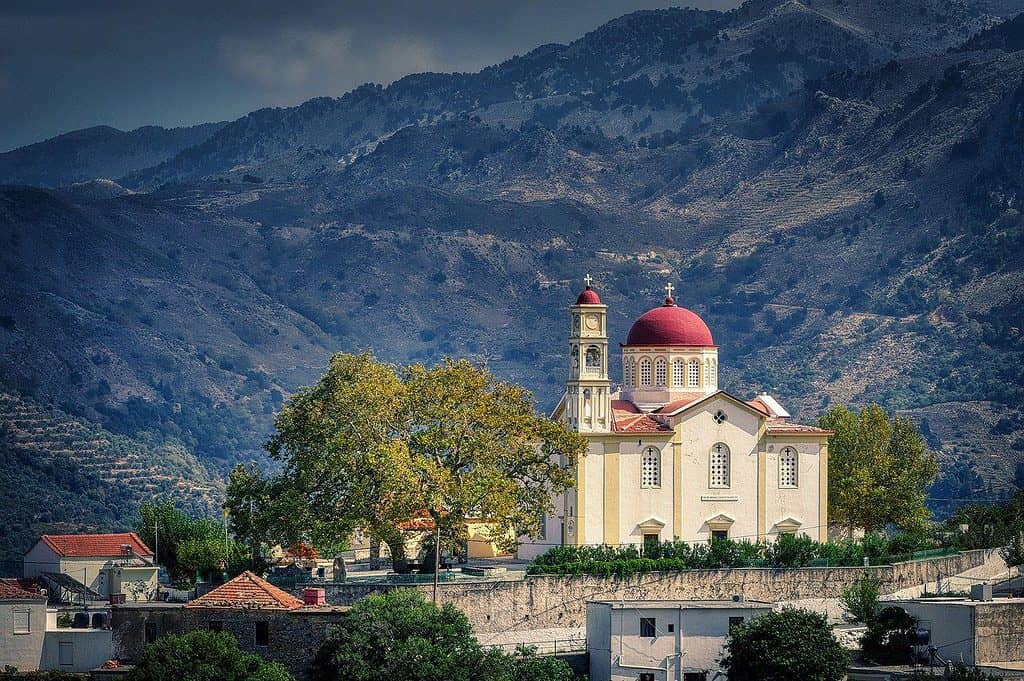
Crete facts are great for anyone with a love of islands – the biggest island in Greece is one filled with new knowledge to talk about!
148. Crete is the 88th largest island in the world.
149. Human civilisation on Crete has been going on for over 130,000 years!
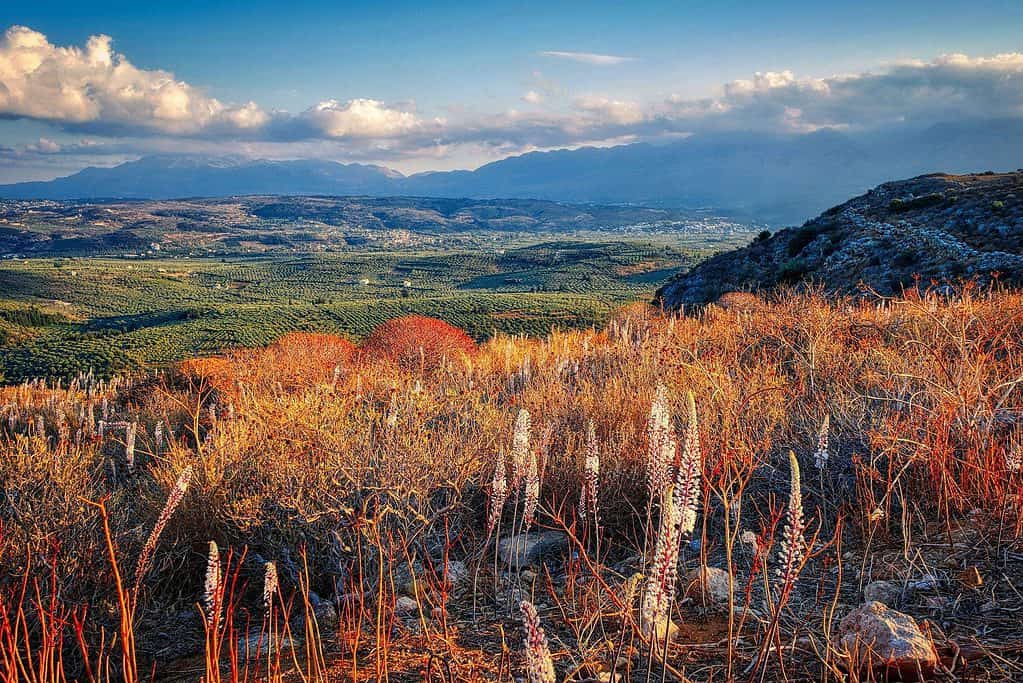
150. Heraklion is the capital of Crete. It is home to the Palace of Knossos and the famous Labyrinth of the Minotaur.
151. Crete chose to become part of modern Greece in 1913.
152. There are two international airports plus one small national airport in Crete.
153. 15% of all tourists to Greece first land in Heraklion airport!
154. Crete’s isolation from the mainland and all the surrounding continents makes their plants and animals much more diverse and individualistic, providing hints to evolutionary patterns.
155. Mantinades are a special kind of musical Cretan poetry that uses call and response and rhyming couplets.
156. The Renaissance artist El Greco, real name Domenikos Theotokopoulos, was born in Crete.
157. The Cretan dialect is a little different from Standard Greek, with a few different words, although they are still the same language and mutually intelligible.
Santorini Facts

These Santorini Greece facts will give you a little insight into one of the country’s most popular islands for foreign and local tourists. Some fun Santorini facts are sure to impress!
158. Santorini is a colloquial name. The island’s official name is Thera, though Santorini is more commonly used. Santorini was the Latin name after Saint Irene.
159. The Minoan Eruption, one of the largest volcanic eruptions in known history, occurred there 3,600 years ago. It might even have been the source of the popular myth of Atlantis!
160. Santorini’s volcanic soil makes the products created there – such as the Santorini cherry tomato – different from anywhere else in the world.
161. Strong earthquakes in 1956 destroyed half of all buildings on the island.
162. There are two ports on Santorini. Athinios (Ferry Port) and Skala (Old Port).
Greek Language Facts
This section offers a quick glance into the modern language and Greek alphabet for kids!
163. There are twenty-four letters in Greek. The first letter of the Greek alphabet is Α/α, alfa (pronounced like ‘a’ in ‘apple’), and the last is Ω/ω, omega (pronounced ‘o’ like ‘go’). Greek letters haven’t changed much in shape since the Ancient Greek characters. All letters only have one sound, so pronunciation is easy!
164. When you’re referring to something specific, it always has to have an article (“the”) – even names! There are three definite articles, η (ee), ο (oh), and το (toe) (feminine, masculine, and neuter). All objects fall into one of these three gender groups. For example, if you were talking about a house, you would say to spiti because it’s a neutral noun, but if you were referring to a door, it would be e porta because the door is feminine. Similarly, if you were talking about your friend, Giorgos, you would say, o filos mou, o Giorgos – both filos (friend) and Giorgos need an article!
165. While in English we’d say my / her / his / its / their BEFORE the thing (e.g. my house) in Greek it comes AFTER – to spiti mou (my house), to spiti sou (your house), to spiti tees (her house) and so on.
166. Some words are very similar to English (blue is bleh, wallet is portofoli, like portfolio), while others are very different – boy is agori and girl is koritsi!
167. A fun fact about Greece is that the accent in the Athens region is very different from both the islands and other places in the mainland.
Related Posts
Is Greece a Third World Country?
What Do Greeks Call Greece in Their Native Language?

